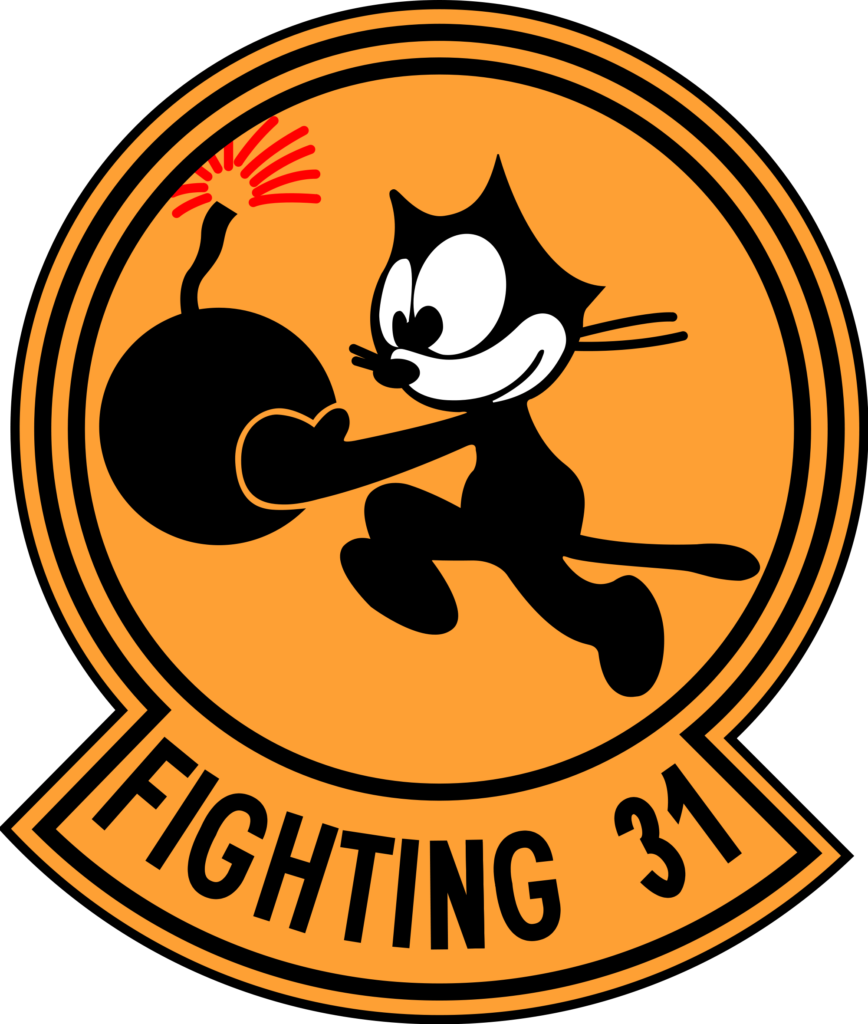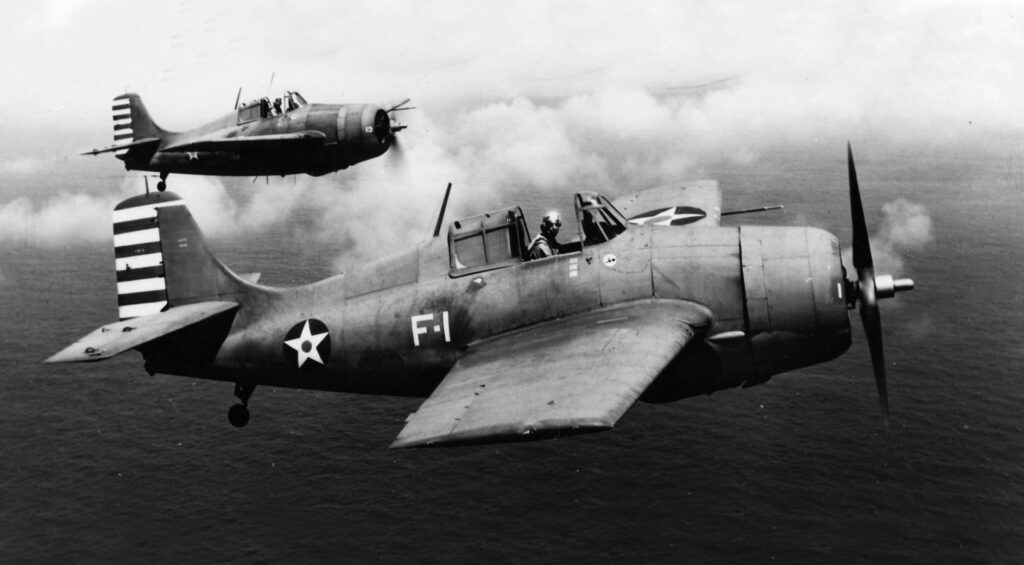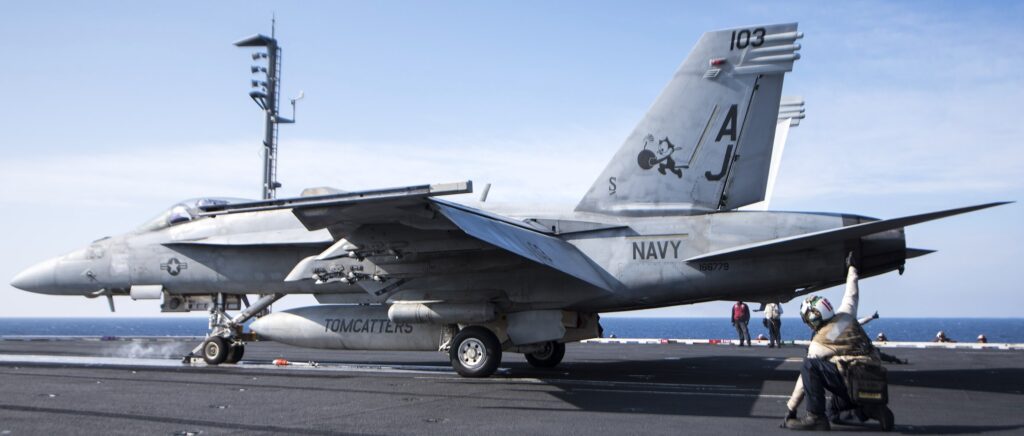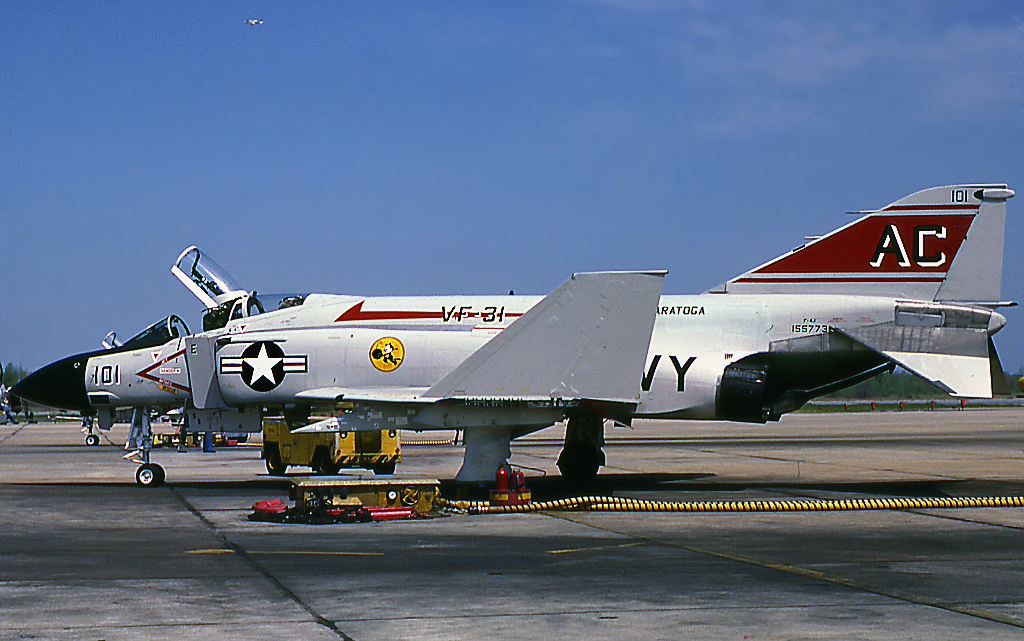VFA-31 (Strike Fighter Squadron 31) is the second oldest Navy attack fighter squadron. Known as the Tomcatters with the call sign “Felix,” it is currently based at Naval Air Station Oceana in Virginia Beach, VA. It flies the F/A-18E Super Hornet. “V” stands for fixed wing, “F” stands for fighter, and “A” stands for attack. Chief Of Naval Operations Instruction (OPNAVINST) governs the squadron designation system. The Navy’s oldest currently active squadron is VFA-14, and it has been redesignated 15 times since it was established in 1919.

The Enduring Tale of Felix and the Tomcatters
Over the history of U. S. Naval Aviation, many designations have been used multiple times, resulting in numerous unrelated squadrons bearing the same designation at different times. The use of letter abbreviations for squadrons was promulgated in the “Naval Aeronautic Organization for Fiscal Year 1923,” which is the first known record associating the abbreviated Aircraft Class Designations (V-heavier than air, Z-lighter than air, and letters designating role) with abbreviated squadron designations. Originally known as the Shooting Stars, this unit began as VF-3 and took on Felix the Cat for its insignia, which remains to this day. It was officially designated VF-31 in 1948. Charles Lindbergh and Butch O’Hare flew with this squadron which had first been established on July 1, 1935, flying the F4B Wildcat. Navy Together We Served currently includes 118 members who have been assigned to this historic unit.

Throughout its history, the unit has flown off several carriers, including the USS Langley, USS Lexington, and USS Enterprise, aboard which they were engaged at Pearl Harbor, Wake Island, Marcus Island, Midway, Guadalcanal, and Eastern Solomons, as well as combat action over the Philippines, Formosa. Okinawa and China. In addition to the current Super Hornet, during their many sorties, they also piloted the F6F Hellcat, F9F Panther, F2H Banshee, F3H Demon, F8F Bearcat, F-4 Phantom, F-14A Tomcat, A-7 Corsair, and A-6 Intruder. Other carriers they have cruised aboard include the USS Saratoga (for twenty-four years), USS John F. Kennedy, USS Independence, USS Forrestal, USS Carl Vinson, USS Abraham Lincoln, USS John C. Stennis, USS Theodore Roosevelt, USS Gerald Ford and maiden voyage of the USS George H.W. Bush. Today, they report operationally to Commander, Carrier Air Wing Eleven, and administratively to Commander, Strike Fighter Wing, Atlantic. “Before converting to the F-14, the Tomcatters had a notable history, being the only U.S. squadron (of all three air arms) to score confirmed kills in three wars: World War II, Korea, and Vietnam. VFA-31s’ association with their namesake, the F-14 Tomcat, began in late 1980…”
The Legacy of Felix – Symbol of the VFA-31 Tomcatters
“Felix is a wily cartoon cat created by Pat Sullivan in 1919. The image of Felix was adopted by Squadron VB-2B in 1928, which took on the name Felix Cat Squadron. The next year, Lt. Emile Chourre, with the help of squadron mates, including Lt. Paul Clyde, created an updated version of the logo featuring Felix running with a bomb. That redesigned logo has been used on this squadron’s aircraft ever since. Felix, the mischievous bomb-toting cat, is now recognized worldwide as the beloved symbol of the VFA-31 Tomcatters. The squadron has changed designations and aircraft many times during its history, but the Felix image has essentially remained the same…” while the unit’s numerical and other aircraft fuselage and tail markings continue to evolve. Since the Tomcat is associated with a particular aircraft nickname which they no longer fly, they are trying to associate its motto as being the Fighting 31st.
Excerpt from a Tomcatter air combat diary by Capt. Dale “Snort” Snodgrass:
“… I was leading a night Fighter Sweep in support of an A-6 strike on a power plant on the north side of Baghdad. My flight had flushed a couple of MiG-29s, and we were in ‘Hot Pursuit.’ My ECM and radar warning gear had been lit up like an X-Mas tree, so I was vigilant in jinking in altitude and heading while rolling and visually checking for missile plumes. During one check, I saw a missile clearing the haze and undercast below us. We were 25-26 thousand feet at the time, and the undercast was broken around 13-15 thousand. The net result is that there is little time to see and react to a Mach 4 missile. Fortunately, I was looking at the right piece of sky as the missile cleared the clouds. I immediately saw it had constant bearing and big time decreasing range. I immediately rolled the Tomcat into the missile and pulled 8-10 G’s while deploying chaff to aid in breaking the missile’s radar lock. The missile exploded just above and behind me. The missile defense worked as advertised (though it was really, really close). Unfortunately, the F-14 tends to depart controlled flight when a very hard rolling pull is executed at high subsonic airspeeds (I was at .95-.97 IMN). It is exacerbated with external stores, and I had two external fuel tanks and six missiles loaded. I was able to recover the jet quickly, but in the process, I lost my right engine…”

VFA-31: Current Deployment and Future
VFA-31 is currently on a scheduled deployment with the Gerald R. Ford Carrier Strike Group in the U.S. Naval Forces Europe area of operations, employed by the U.S. Sixth Fleet to defend U.S. interests. This squadron has been established as:
Since 2006, the unit has been flying the Boeing F/A-18E Super Hornet. It was announced that Boeing will not accept any more orders for these multi-role fighters. It is planned that the last eight production aircraft for the U.S. Navy will be made in 2025, and the production line for the Super Hornet will be closed. The Tomcatter squadron’s 21st-century deployments have been:
September 2008 – April 2009 with CVW-8 aboard USS Theodore Roosevelt
May 2011 – December 2011 with CVW-8 aboard USS George H. W. Bush
February 2014 – November 2014 with CVW-8 aboard USS George H. W. Bush
January 2017 – August 2017 with CVW-8 aboard USS George H. W. Bush
May 2019, with CVW-11 aboard USS Theodore Roosevelt
January 2020 – July 2020 with CVW-11 aboard USS Theodore Roosevelt
December 2020 – May 2021 with CVW-11 aboard USS Theodore Roosevelt
October 2022 – November 2022 with CVW-8 aboard USS Gerald R. Ford
May 2023 – present with CVW-8 aboard USS Gerald R. Ford
The ship’s squadron complement is ten to twelve aircraft. They describe their weapon this way, “We fly the single-seat variant of the Navy’s strike fighter aircraft, the F/A-18E Super Hornet. This model was designed for traditional air superiority, fighter escort, reconnaissance, aerial refueling, close air support, forward air control (airborne), air defense suppression, and day/night precision strike, at the same time increasing strike mission survivability and supplementing the fleet air defense.” According to Rand Corporation USAF estimates, the cost of building a single one of these fighters is $70 million, and a single fighter pilot’s training costs range from about $6 to $10 million. The USS Gerald Ford cost a little more than $13 billion to build. Over time, the squadron’s investment in and dedication to national defense cannot be calculated.
Read About Other Famous Military Units
If you enjoyed learning about VFA-31 Tomcatters, we invite you to read about other Famous Units on our blog. You will also find military book reviews, veterans’ service reflections and more on the TogetherWeServed.com blog. If you are a veteran, find your military buddies, view historic boot camp photos, build a printable military service plaque, and more on TogetherWeServed.com today.

I was in VF-31 75-78. I probably worked on the F4 pictured.
I was in VF-31 in the late ’60s, and updated the squadron history. In addition to the aircraft listed, the squadron operated with the Grumman F3H, F4H Wildcat, Brewster F2A Buffalo, and all models of the operational Grumman F-14 … not just the F-14A. There are also indications that the squadron evaluated the ’40s McDonnell FD/FH-1 Phantom.
I know no reason why they would have operated with the Grumman A-6 Intruder or the Vought A-7 Corsair as listed.
A small errata: in the second paragraph, this mentions F4B Wildcat … that should be F4H. The F4B was a ’30s Boeing naval fighter.
My husband, Tom Inderlied, flew the F4 off Saratoga in Viet Nam. It was an amazing time in his life and his stories always included his pride in the ship and his shipmates. I am proud to be connected through him to such a fine and storied military experience.
Thank you for this excellent article on a beautiful, if deadly, piece of war craft. I was told once that the F-4 was the only Navy airplane Hong Kong did not allow to land at their airport as it looked too warlike. True or not, good sea story.